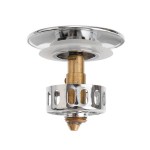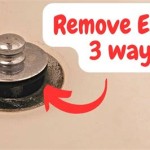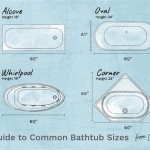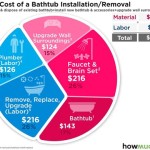How To Take a Bath Without a Bathtub
Bathing is a fundamental aspect of personal hygiene, contributing to overall health and well-being. While a bathtub is often considered the standard vessel for a bath, it is not a universally accessible amenity. Many individuals reside in homes or apartments lacking bathtubs, and others may have physical limitations that make traditional bathtub access challenging. Consequently, alternative methods for achieving a thorough and relaxing bathing experience are necessary. This article explores various effective techniques for taking a bath without a bathtub, providing practical guidance and highlighting considerations for safety and comfort.
Individuals may find themselves without a bathtub due to a variety of reasons. Space constraints in smaller living environments frequently preclude the installation of a bathtub. Renovations aimed at optimizing bathroom layouts may also result in its removal. Furthermore, adapting to evolving needs, such as aging in place or accommodating mobility challenges, may lead to replacing a bathtub with a walk-in shower or other accessible bathing solutions. Regardless of the reason, understanding alternative bathing methods is crucial for maintaining hygiene and personal care routines.
These alternative methods prioritize cleanliness, relaxation, and personal preference. The primary objective is to achieve a bathing experience that approximates the benefits of a traditional bathtub soak, even in its absence. Techniques range from focused cleansing routines to modified shower experiences designed to mimic a bath's therapeutic effects. Each method presents its own set of advantages and considerations, allowing individuals to tailor their bathing routine to their specific circumstances and resources.
The Shower as a Bath Substitute
The most readily available alternative to a bathtub is the shower. While a quick shower is often perceived as purely functional, it can be adapted to provide a more bath-like experience. This adaptation primarily involves modifying the shower environment and technique to encourage relaxation and thorough cleansing.
First, ensure the shower enclosure is clean and free from obstructions. Accumulation of soap scum and mildew can detract from the bathing experience and pose hygiene concerns. Appropriate cleaning products should be used regularly to maintain a sanitary environment. Furthermore, verify that the shower drain is clear to prevent water from pooling, which can be both inconvenient and increase the risk of slipping.
To enhance the shower experience, consider incorporating aromatherapy. Essential oils, such as lavender or eucalyptus, can be added to a diffuser or placed on the shower floor (away from direct water flow) to release their fragrance. The steam from the shower will help to disperse the aroma, creating a more relaxing atmosphere. It is important to select essential oils that are safe for inhalation and avoid direct contact with skin, as some may cause irritation.
Another method for transforming a shower into a bath-like experience involves using a shower steamer. Shower steamers are similar to bath bombs but are designed to be used in a shower. They typically contain essential oils and other ingredients that release a fragrant and soothing vapor when activated by water. Place the shower steamer on the shower floor, away from the direct stream of water, to allow it to dissolve slowly and release its aroma.
For a more thorough cleansing experience, use a loofah or exfoliating scrub. These tools help to remove dead skin cells and improve circulation. When using a loofah, be sure to rinse it thoroughly after each use and allow it to dry completely to prevent the growth of bacteria. Exfoliating scrubs should be used sparingly to avoid irritating the skin.
Furthermore, adjusting the water temperature can significantly influence the shower experience. While a hot shower can be relaxing, it can also dry out the skin. A lukewarm shower is generally a better option for maintaining skin hydration. Experiment with different water temperatures to find what feels most comfortable and beneficial.
Finally, consider the duration of the shower. A longer shower allows for more thorough cleansing and relaxation. However, it is important to be mindful of water conservation. Reducing the water flow or installing a low-flow showerhead can help to minimize water consumption.
The Sponge Bath: A Targeted Cleansing Approach
A sponge bath provides a practical solution when a full bath or shower is not feasible. This method involves using a washcloth or sponge to cleanse the body, offering a targeted approach to hygiene. It is particularly useful for individuals with limited mobility or those recovering from illness or surgery.
To prepare for a sponge bath, gather the necessary supplies: a basin filled with warm water, a washcloth or sponge, soap, a towel, and any necessary toiletries. The water temperature should be comfortable to the touch, not too hot or too cold. Soaps should be hypoallergenic and gentle on the skin to prevent irritation. The towel should be clean and readily accessible to dry the skin after cleansing.
Begin by washing the face with a clean washcloth. Use gentle, circular motions to cleanse the skin. Pay particular attention to the areas around the eyes, nose, and mouth. Rinse the washcloth thoroughly and repeat the process to remove any remaining soap residue. Avoid using soap directly on the eyes.
Next, proceed to wash the rest of the body. Start with the upper body, working your way down. Wet the washcloth or sponge, apply a small amount of soap, and gently cleanse the skin. Focus on areas that tend to accumulate sweat and dirt, such as the underarms, groin, and feet. Rinse the washcloth or sponge frequently to remove soap and dirt.
When washing the lower body, pay particular attention to the genital area. Use a clean washcloth and gentle soap to cleanse the area. Rinse thoroughly with warm water. For individuals with limited mobility, it may be helpful to use a long-handled sponge to reach the back and lower extremities.
After cleansing the entire body, use a clean, dry towel to pat the skin dry. Avoid rubbing the skin, as this can cause irritation. Pay particular attention to drying the areas between the toes and under the arms to prevent the growth of bacteria and fungi.
A sponge bath can be a refreshing and effective way to maintain hygiene when a traditional bath or shower is not possible. It is a practical option for individuals of all ages and abilities, offering a targeted approach to cleansing and personal care.
Modifying the Shower Environment for Accessibility and Comfort
Beyond simple hygiene, the bathing experience can be enhanced by modifying the existing shower environment to promote accessibility, relaxation, and comfort. This involves incorporating elements that cater to individual needs and preferences, transforming the shower from a purely functional space into a more therapeutic one.
For individuals with mobility limitations, installing grab bars in the shower is crucial. Grab bars provide support and stability, reducing the risk of falls. They should be strategically placed near the shower entrance and along the shower walls, allowing individuals to maintain their balance while entering, exiting, and moving around in the shower. Ensure that the grab bars are securely installed and can support the individual's weight.
A shower chair or bench can also significantly enhance the bathing experience for individuals with mobility limitations. A shower chair provides a comfortable and stable seating option, allowing individuals to bathe without having to stand for prolonged periods. Select a shower chair that is appropriate for the individual's size and weight. The chair should also be slip-resistant to prevent accidents.
Improving water temperature control is essential for both comfort and safety. A thermostatic mixing valve can help to maintain a consistent water temperature, preventing sudden fluctuations that can be scalding or uncomfortable. This is particularly important for individuals with sensitive skin or those who may be unable to react quickly to changes in water temperature.
Adequate lighting is also crucial for creating a safe and comfortable shower environment. Install bright, non-glare lighting to improve visibility. Consider adding a nightlight to the bathroom to prevent falls during nighttime trips to the shower. Non-slip mats or adhesive strips should be placed on the shower floor to prevent slips and falls. These mats provide traction, reducing the risk of accidents.
Finally, consider incorporating elements that promote relaxation and sensory stimulation. A waterproof Bluetooth speaker can be used to play music or podcasts during the shower. Adding plants to the bathroom can create a more calming and natural atmosphere. Experiment with different shower gels, shampoos, and conditioners to find scents and formulations that you find enjoyable and beneficial.
By modifying the shower environment, individuals can create a bathing space that is both safe and enjoyable. This approach prioritizes accessibility, comfort, and personal preference, transforming the shower from a purely functional space into a more therapeutic and relaxing one.

7 Master Bathrooms Without Tubs To Inspire Your Remodel

Small Bathroom Design Ideas Do You Need A Bathtub Bath Fixer

Bathrooms Without A Bath Brindabella

How To Bathe Infants Without A Tub Cloud Surfing Kidscloud Kids

House With No Bathtub Babycenter

6 Life Changing Ways To Use Bath Salt Without A Bathtub
Traveling With Baby How To Bath A In Room Without Tub Brie Blooms

How To Take A Bath 15 Steps With Pictures Wikihow

How To Shower And Bathe Properly Steps What Not Do

How To Bathe A Baby Without Tub
Related Posts








